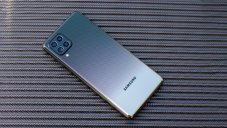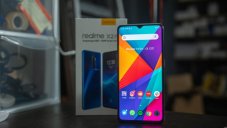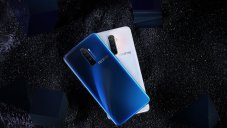Realme X2 Pro
$355 | 31999
- 6.5" 1080x2400 pixels
- 64MP 2160p
- 6-12GB RAM Snapdragon 855+
- 4000mAh Li-Po
Phone Finder
- Acer alcatel Allview Amazon Amoi Apple Archos Asus AT&T Benefon BenQ BenQ-Siemens Bird BlackBerry Blackview BLU Bosch BQ Casio Cat Celkon Chea Coolpad Cubot Dell Doogee Emporia Energizer Ericsson Eten Fairphone Fujitsu Siemens Garmin-Asus Gigabyte Gionee Google Haier HMD Honor HP HTC Huawei i-mate i-mobile Icemobile Infinix Innostream iNQ Intex itel Jolla Karbonn Kyocera Lava LeEco Lenovo LG Maxon Maxwest Meizu Micromax Microsoft Mitac Mitsubishi Modu Motorola MWg NEC Neonode NIU Nokia Nothing Nvidia O2 OnePlus Oppo Orange Oscal Oukitel Palm Panasonic Pantech Parla Philips Plum Posh Prestigio QMobile Qtek Razer Realme Sagem Samsung Sendo Sewon Sharp Siemens Sonim Sony Sony Ericsson Spice T-Mobile TCL Tecno Tel.Me. Telit Thuraya Toshiba Ulefone Umidigi Unnecto Vertu verykool vivo VK Mobile Vodafone Wiko WND XCute Xiaomi XOLO Yezz Yota YU ZTE
Realme X2 Pro Summary
Realme might be the newest and least well known of the BBK Electronics family that includes Oppo, Vivo, and OnePlus, but it’s certainly no less ambitious. After starting out as an Oppo sub-brand it was given license to operate more independently in 2017, and since then Realme has sold so many devices that it’s now the fastest-growing smartphone maker in the world. Its foray into the European market only really began in earnest this year, but aggressive pricing looks to be to paying dividends as it goes after more established Chinese rivals such as Xiaomi and Honor/Huawei.
The X2 Pro is the company’s first proper flagship, and it quickly grabbed our attention when it was introduced to the European market in October due to the insane spec to price ratio. For just €399, it’s equipped with a Snapdragon 855+, a 90Hz display, 50W charging and a 64MP primary lens as part of a quad camera setup. Take a look at the full spec list below and you’ll wonder how it costs so little, especially in view of the rising costs of smartphones over the last few years. Being cheap is not the same as offering great value, however, but I’m glad to say the X2 Pro does both. It’s not perfect, by any means, but it’s rare to get this much for your money nowadays.
Realme X2 Pro: Design
It’s easy to see where the Realme X2 Pro gets its looks from — the rear and sides of the device remind me a lot of the Realme X. From the Lunar White color used on the back, to the centrally-placed camera housing, to the aluminum rail that lines the sides of the device, the two definitely share some DNA. The main difference here is that the X2 Pro’s back is now glass over the plastic used last time around, leading to a much more premium-feeling device.
The curved rear glass creates an ergonomic feel in the hand, and thanks to the flat front glass, accidental touches are minimal. The phone itself is very easy to grip thanks to its slightly tapered sides, and doesn’t feel like it’s going to fall out of the hand in a hurry. On a similar note, the right-side mounted power button and left-mounted volume buttons are very tactile and crisp feeling, with no wobble or lateral movement.
Realme X2 Pro: Display
High refresh rate displays are in right now, and Realme has capitalized on this, giving the X2 Pro a silky-smooth 90Hz Super AMOLED panel. The 6.5-inch Full HD+ screen, topped with Gorilla Glass 5, is impressive to say the least.
At over 480 nits, the Realme X2 Pro’s display gets surprisingly bright, making outdoor viewing easy as pie, even on the rare sunny days here in England! As for sharpness, I found the X2 Pro to perform admirably, providing more than adequate detail in all scenarios tested, including reading fine text from a zoomed-out article.
Like its predecessor, the Realme X2 Pro’s screen isn’t incredibly color accurate — thankfully the blue shift has been minimized in all but extreme off-axis viewing angles. There is still a color-temperature issue, however. Our testing shows the display sitting a very cool 7700 kelvin in both Vivid and Gentle modes. For reference, a well-calibrated display will sit at around 7000 kelvin.
Realme X2 Pro: Performance
Where the X2 Pro really excels is performance. That’s unsurprising given the internals comprise a Snapdragon 855+ chip, 6/8/12GB of RAM, and at least 64GB of storage (which is UFS 3.0 on the 128 and 256GB models). You’ll be hard pushed to find a faster phone out there. It chugs through even the most intense applications and games without complaint, although it does sometimes get a little toasty. The config I’ve been using is maxed out at 12GB of RAM and 256GB of storage, but that’s overkill, so I’d expect even the cheapest base model (6GB) to have no memory management issues. Depending on how you use your phone, 64GB of storage might be more of an issue, but it’s only €50 extra to upgrade to the 8/128GB variant, which is also UFS 3.0 — that’s a really good deal if you can afford it.
Realme X2 Pro: Camera
The Realme X2 Pro uses the same 64-megapixel f/1.8 primary camera as the Realme XT, but with different companion sensors. The 2-megapixel macro camera has been ditched for a more useful 13-megapixel telephoto camera. This is capable of 2X optical zoom, 5X hybrid zoom, and a total of 20X digital zoom. There's also an 8-megapixel wide-angle camera with an f/2.2 aperture and a 115-degree field of view, and finally a 2-megapixel depth sensor. There's no optical stabilisation on any of the cameras, but your do get electronic stabilisation for video.
The camera app in ColorOS 6.1 has some new features. Nightscape now works for the selfie camera; you can finally adjust the level of background blur in Portrait mode; and the wide-angle camera can be used to shoot video. Realme has also added an ‘Ultra Steady' shooting mode, much like what we saw on the Oppo Reno 2 (Review), for enhanced stabilisation.
The primary sensor captures 16-megapixel oversampled photos by default. Under good light, our samples looked detailed. Colours were vivid and HDR did a good job of balancing the exposures of light and dark areas. Objects to the sides of the frame exhibited noticeable grain but objects in the focus area didn't have this issue. You can shoot at the full 64-megapixel resolution if you need a higher degree of zoom later on. Portrait mode worked well too, with good edge detection.
Realme X2 Pro: Battery
This device has a 4,000mAh battery and the ability to charge exceedingly fast with an in-box 50W SuperVOOC Flash Charger. If you purchase this phone in a region outside of your own, you’ll get the charger unique to that region. This is fine for most regions, but if you’re part of SlashGear’s primary readership, you likely live in the USA, and you’re going to need a converter.
Once we had everything in order, this charger was a beast. This charger with this phone will, ideally, charge the phone from dead to completely full in around a half hour. There’s no wireless charging here, but the fact that we can get the entirety of this 4,000mAh battery full in less than an hour is nothing at which we can scoff.
Realme X2 Pro Full Specifications
- Dollas $355 Buy in Flipkart >
- Rupee ₹31999 Buy in Flipkart >
- Technology GSM / CDMA / HSPA / EVDO / LTE
- 2G bands GSM 850 / 900 / 1800 / 1900 - SIM 1 & SIM 2
- 1, 2, 3, 4, 5, 7, 8, 12, 17, 18, 19, 20, 26, 28, 34, 38, 39, 40, 41 - EMEA
- 3G bands HSDPA 850 / 900 / 1700(AWS) / 1900 / 2100 - China
- 4G bands 1, 2, 3, 4, 5, 7, 8, 12, 17, 18, 19, 20, 26, 34, 38, 39, 40, 41 - China
- Speed HSPA 42.2/11.5 Mbps, LTE-A
- Announced 2019, October
- Status Available. Released 2019, October
- Dimensions 161 x 75.7 x 8.7 mm (6.34 x 2.98 x 0.34 in)
- Weight 199 g (7.02 oz)
- Build Glass front (Gorilla Glass 5), glass back (Gorilla Glass 5), aluminum frame
- SIM Dual SIM (Nano-SIM, dual stand-by)
- Type Super AMOLED capacitive touchscreen, 16M colors
- Size 6.5 inches, 103.5 cm2 (~84.9% screen-to-body ratio)
- Resolution 1080 x 2400 pixels, 20:9 ratio (~402 ppi density)
- Protection Corning Gorilla Glass 5
- 1000 nits max brightness (advertised) 90Hz refresh rate HDR10+
- OS Android 9.0 (Pie), upgradable to Android 10.0; realme UI
- Chipset Qualcomm SM8150 Snapdragon 855+ (7 nm)
- CPU Octa-core (1x2.96 GHz Kryo 485 & 3x2.42 GHz Kryo 485 & 4x1.8 GHz Kryo 485)
- GPU Adreno 640 (700 MHz)
- Card slot No
- Internal 64GB 6GB RAM, 128GB 8GB RAM, 256GB 12GB RAM
- 64GB UFS 2.1, 128/256GB UFS 3.0
- Modules 64 MP, f/1.8, 26mm (wide), 1/1.72", 0.8µm, PDAF 13 MP, f/2.5, 52mm (telephoto), 1/3.4", 1.0µm, PDAF, 2x optical zoom 8 MP, f/2.2, 16mm (ultrawide) 2 MP, f/2.4, (depth)
- Features Dual-LED flash, HDR, panorama
- Video 2160p@30/60fps, 1080p@30/60/120fps, 720p@960fps, gyro-EIS
- Modules 16 MP, f/2.0, 25mm (wide), 1/3", 1.0µm
- Features HDR
- Video 1080p@30fps, gyro-EIS
- Loudspeaker Yes, with Dolby Atmos stereo speakers (2 dedicated amplifiers)
- 3.5mm jack Yes
- 24-bit/192kHz audio (incl. speakers)
- WLAN Wi-Fi 802.11 a/b/g/n/ac, dual-band, Wi-Fi Direct, hotspot
- Bluetooth 5.0, A2DP, LE
- GPS Yes, with dual-band A-GPS, GLONASS, BDS, GALILEO
- NFC Yes
- Radio FM radio
- USB 2.0, Type-C 1.0 reversible connector
- Sensors Fingerprint (under display, optical), accelerometer, gyro, proximity, compass
- Non-removable Li-Po 4000 mAh battery
- Charging Fast charging 50W, 100% in 35 min (advertised) SuperVOOC
- Colors Lunar White, Neptune Blue, Red Master Edition, Gray Master Edition
- Models RMX1931
- Performance AnTuTu: 396827 (v7), 467653 (v8) GeekBench: 10373 (v4.4) GFXBench: 37fps (ES 3.1 onscreen)
- Display Contrast ratio: Infinite (nominal)
- Camera Photo
- Loudspeaker Voice 82dB / Noise 75dB / Ring 91dB
- Audio quality Noise -91.3dB / Crosstalk -92.5dB
- Battery life Endurance rating 94h
Realme X2 Pro News

Mobile - Mar 15, 2021
Six Best Smartphones Under 40,000 In India: Price & Detailed Review

Mobile - Mar 09, 2021
Best Phone Under 30000 In India 2020 That You Can Take A Look At (9 March 2021)

Mobile - Dec 21, 2019
Realme To Launch New Variant Of Realme X2 Pro At A Cheaper Price

Mobile - Dec 20, 2019
Realme Reached 15 Million Phones Sold In India In Its First Year; Aim To Double In...

Mobile - Nov 26, 2019











